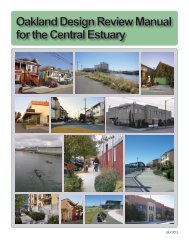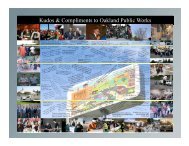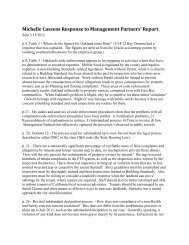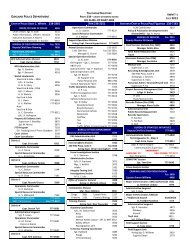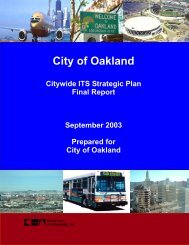The Bratton Group Report - City of Oakland
The Bratton Group Report - City of Oakland
The Bratton Group Report - City of Oakland
You also want an ePaper? Increase the reach of your titles
YUMPU automatically turns print PDFs into web optimized ePapers that Google loves.
done in the past. Because each unit is working in a manageable area instead <strong>of</strong> <br />
citywide, the DIUs are also more likely to identify patterns and learn the identifying <br />
characteristics and modus operandi <strong>of</strong> the local criminals, whether robbery, <br />
burglary or shooting suspects. In addition, actively working cases in the field, <br />
debriefing people arrested by uniformed <strong>of</strong>ficers and developing informants can <br />
<strong>of</strong>ten result in solving crimes that initially had few leads. <br />
<strong>The</strong> DIU investigators will require significant support from the Department, the <br />
crime scene technicians, and the Criminalistics division. In robberies, a key piece <strong>of</strong> <br />
evidence is <strong>of</strong>ten the criminal’s appearance and the ability <strong>of</strong> the victim to identify <br />
the assailant. It is therefore important to provide searchable digital photo files so <br />
that robbery investigators can quickly assemble photo arrays to show to victims and <br />
witnesses in a timely fashion after the robbery has occurred. <strong>The</strong> <strong>Bratton</strong> <strong>Group</strong> <br />
team has learned that this is rarely done now because the Department’s system <strong>of</strong> <br />
electronic access to the photo files <strong>of</strong> the Alameda County Consolidated Arrest <br />
<strong>Report</strong> System (CARS) is extremely slow, and it takes far too much time to assemble <br />
photo arrays. Digital photo file systems are not expensive compared with many <br />
other forms <strong>of</strong> police technology, and it is strongly urged that the <strong>City</strong> <strong>of</strong> <strong>Oakland</strong> <br />
and the Department develop the capacity to readily consult and use this important <br />
evidentiary tool. <br />
In burglary, a key piece <strong>of</strong> evidence is <strong>of</strong>ten fingerprints left on surfaces in a <br />
burglarized property. <strong>The</strong> OPD evidence technicians regularly dust for latent prints <br />
at burglary scenes. An evidence tech interviewed by the <strong>Bratton</strong> <strong>Group</strong> team <br />
estimated that he alone responds to 200 to 300 burglaries a year and finds prints <strong>of</strong> <br />
apparent value in many cases. Most <strong>of</strong> these prints are never examined or entered <br />
into the Automated Fingerprint Identification System (AFIS), which might be able to <br />
provide matches with previously arrested persons. <strong>The</strong> fingerprint section <strong>of</strong> the <br />
Criminalistics Division is understaffed and devotes most <strong>of</strong> its time to working on <br />
homicide cases that require intensive work because a print match may be the only <br />
<br />
<strong>The</strong> <strong>Bratton</strong> <strong>Group</strong>, LLC <br />
8








